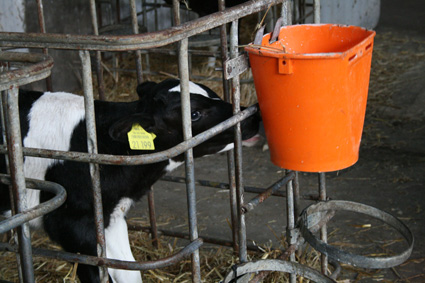 During a recent visit to a dairy farm, I spotted one of the farm workers filling an orange bucket with milk. Why? That’s what I wondered too.
During a recent visit to a dairy farm, I spotted one of the farm workers filling an orange bucket with milk. Why? That’s what I wondered too.
The bucket had a nipple attached for newborn calves who aren’t able to drink directly from the bucket yet! As the farmhand approached, the calves really went crazy with deep, insistent moos that you wouldn’t expect from a wobbly legged calf but rather a full-grown bull.
My husband’s cousin explained that each newborn has their separate mini-stall to keep them calm and relaxed, otherwise they might take to kicking and biting. In the afternoons, they are set out in the pasture one at a time to roam the grass along the enormous milk cows whose stall was in view directly across the tiny courtyard.
“Milking cows are not overfed”, cousin Jochen explained, as I pointed to a muscular momma who’s only bulge was a blooming utter beneath a shiny coat.
“We want the cows to be at optimal health so they can have energy to produce the milk on a regular basis and be disease-free,” Jochen mentions.
“Does the milking process hurt them?” I asked. Jochen shook his head, “No they are used to it – it’s a relief for them.” The cows line up for the milking room, eager to “take a load off”, some 20-40 liters of milk (about 5-10 gallons) that weigh down their utters daily – utters looking like rubber water bottles ready to burst.
The cows lined up on their own to walk into an immaculately clean, concrete-covered room with an open entrance and exit. The milking room was silent except for the spritzing of milk as it hit the inside of the dozen holding tanks.
For someone that hasn’t grown up on a farm, the entire business of milk production was a lot more straightforward than I had imagined. Drop in next week when I’ll follow the trail of fresh milk as I visit an “bio” or organic farms that sells their own!
Related Posts
- Find out how I ended up on the farm with cows and champagne.
- Looking for more travel and delicious food, check out my first trip to Mexico.
- Learn how to be healthier while traveling.


 Are you ready to look better, feel more energized, and get back that youthful feeling you remember having as a kid? I can help you on a journey that will change the way you eat — for good. My
Are you ready to look better, feel more energized, and get back that youthful feeling you remember having as a kid? I can help you on a journey that will change the way you eat — for good. My 














 As a healthy cooking expert, health coach and TV host,
As a healthy cooking expert, health coach and TV host, 



Speak Your Mind